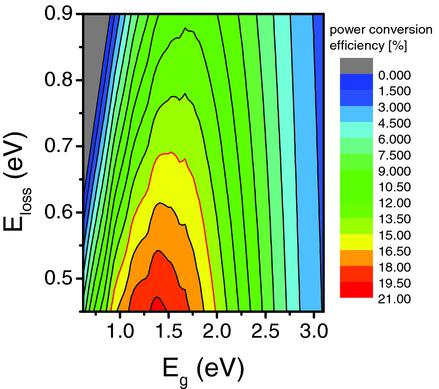当前位置:
X-MOL 学术
›
Small Methods
›
论文详情
Our official English website, www.x-mol.net, welcomes your feedback! (Note: you will need to create a separate account there.)
Toward Over 15% Power Conversion Efficiency for Organic Solar Cells: Current Status and Perspectives
Small Methods ( IF 12.4 ) Pub Date : 2017-11-08 , DOI: 10.1002/smtd.201700258 Jianqi Zhang 1 , Lingyun Zhu 1 , Zhixiang Wei 1
Small Methods ( IF 12.4 ) Pub Date : 2017-11-08 , DOI: 10.1002/smtd.201700258 Jianqi Zhang 1 , Lingyun Zhu 1 , Zhixiang Wei 1
Affiliation

|
Significant improvement in the power conversion efficiency (PCE) of organic solar cells (OSCs) is achieved by developing novel donor and acceptor materials, optimizing the phase‐separation morphology via diversified strategies, and using interfacial materials for better charge‐carrier collection. For state‐of‐the‐art devices, a PCE of over 13% is reported. However, simulations indicate that an efficiency of ≈19% could be realized, assuming a total energy loss of 0.5 eV with an external quantum efficiency of 90% and a fill factor of 70%. This large difference between the theoretical calculations and the actual performance of the state‐of‐the‐art devices shows that OSCs have significant potential for the future. Here, the energy loss is discussed, which determines the PCE limit, and then different systems are reviewed, such as small‐molecule (SM)/fullerene blends, polymer/fullerene blends, SM/nonfullerene blends, polymer/nonfullerene blends, and multicomponent systems. After highlighting the factors that have limited the device efficiency to date, an outlook on the most important challenges to guide OSCs toward the 15% PCE regime is provided.
中文翻译:

有机太阳能电池的功率转换效率将超过15%:现状和展望
通过开发新型供体和受体材料,通过多种策略优化相分离形态以及使用界面材料以更好地收集电荷载流子,可以显着提高有机太阳能电池(OSC)的功率转换效率(PCE)。对于最先进的设备,报告的PCE超过13%。但是,仿真表明,假设总能量损失为0.5 eV,外部量子效率为90%,填充系数为70%,则可以实现≈19%的效率。最先进设备的理论计算与实际性能之间的巨大差异表明OSC在未来具有巨大潜力。在此,我们讨论了能量损耗,它确定了PCE极限,然后对不同的系统进行了回顾,例如小分子(SM)/富勒烯共混物,聚合物/富勒烯共混物,SM /非富勒烯共混物,聚合物/非富勒烯共混物和多组分体系。在强调了迄今为止限制设备效率的因素之后,提供了指导OSC迈向15%PCE体制的最重要挑战的展望。
更新日期:2017-11-08
中文翻译:

有机太阳能电池的功率转换效率将超过15%:现状和展望
通过开发新型供体和受体材料,通过多种策略优化相分离形态以及使用界面材料以更好地收集电荷载流子,可以显着提高有机太阳能电池(OSC)的功率转换效率(PCE)。对于最先进的设备,报告的PCE超过13%。但是,仿真表明,假设总能量损失为0.5 eV,外部量子效率为90%,填充系数为70%,则可以实现≈19%的效率。最先进设备的理论计算与实际性能之间的巨大差异表明OSC在未来具有巨大潜力。在此,我们讨论了能量损耗,它确定了PCE极限,然后对不同的系统进行了回顾,例如小分子(SM)/富勒烯共混物,聚合物/富勒烯共混物,SM /非富勒烯共混物,聚合物/非富勒烯共混物和多组分体系。在强调了迄今为止限制设备效率的因素之后,提供了指导OSC迈向15%PCE体制的最重要挑战的展望。



























 京公网安备 11010802027423号
京公网安备 11010802027423号